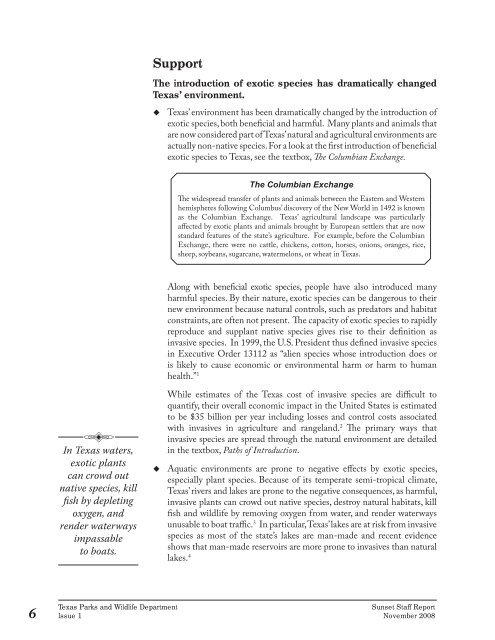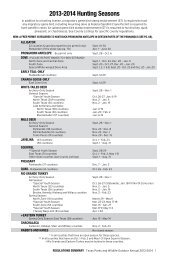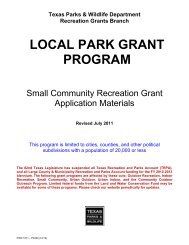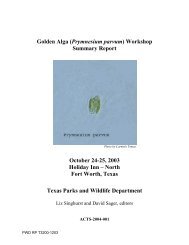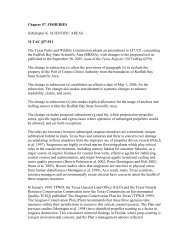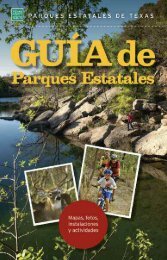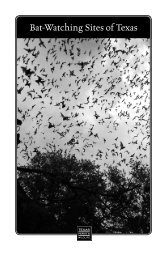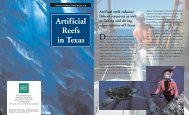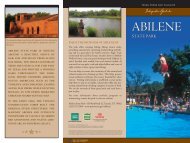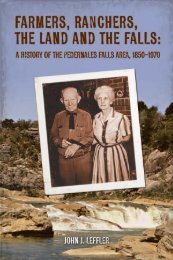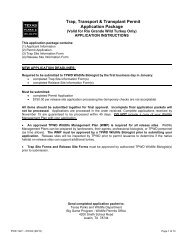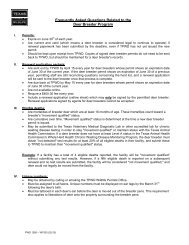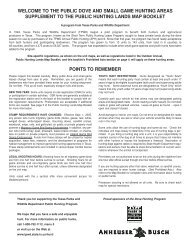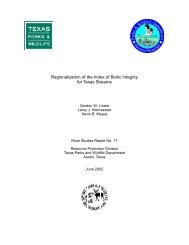Sunset Advisory Commission Staff Report: Texas Parks and Wildlife ...
Sunset Advisory Commission Staff Report: Texas Parks and Wildlife ...
Sunset Advisory Commission Staff Report: Texas Parks and Wildlife ...
You also want an ePaper? Increase the reach of your titles
YUMPU automatically turns print PDFs into web optimized ePapers that Google loves.
Support<br />
The introduction of exotic species has dramatically changed<br />
<strong>Texas</strong>’ environment.<br />
<br />
<strong>Texas</strong>’ environment has been dramatically changed by the introduction of<br />
exotic species, both beneficial <strong>and</strong> harmful. Many plants <strong>and</strong> animals that<br />
are now considered part of <strong>Texas</strong>’ natural <strong>and</strong> agricultural environments are<br />
actually non-native species. For a look at the first introduction of beneficial<br />
exotic species to <strong>Texas</strong>, see the textbox, The Columbian Exchange.<br />
The Columbian Exchange<br />
The widespread transfer of plants <strong>and</strong> animals between the Eastern <strong>and</strong> Western<br />
hemispheres following Columbus’ discovery of the New World in 1492 is known<br />
as the Columbian Exchange. <strong>Texas</strong>’ agricultural l<strong>and</strong>scape was particularly<br />
affected by exotic plants <strong>and</strong> animals brought by European settlers that are now<br />
st<strong>and</strong>ard features of the state’s agriculture. For example, before the Columbian<br />
Exchange, there were no cattle, chickens, cotton, horses, onions, oranges, rice,<br />
sheep, soybeans, sugarcane, watermelons, or wheat in <strong>Texas</strong>.<br />
Along with beneficial exotic species, people have also introduced many<br />
harmful species. By their nature, exotic species can be dangerous to their<br />
new environment because natural controls, such as predators <strong>and</strong> habitat<br />
constraints, are often not present. The capacity of exotic species to rapidly<br />
reproduce <strong>and</strong> supplant native species gives rise to their definition as<br />
invasive species. In 1999, the U.S. President thus defined invasive species<br />
in Executive Order 13112 as “alien species whose introduction does or<br />
is likely to cause economic or environmental harm or harm to human<br />
health.” 1<br />
•••<br />
In <strong>Texas</strong> waters,<br />
exotic plants<br />
can crowd out<br />
native species, kill<br />
fish by depleting<br />
oxygen, <strong>and</strong><br />
render waterways<br />
impassable<br />
to boats.<br />
<br />
While estimates of the <strong>Texas</strong> cost of invasive species are difficult to<br />
quantify, their overall economic impact in the United States is estimated<br />
to be $35 billion per year including losses <strong>and</strong> control costs associated<br />
with invasives in agriculture <strong>and</strong> rangel<strong>and</strong>. 2 The primary ways that<br />
invasive species are spread through the natural environment are detailed<br />
in the textbox, Paths of Introduction.<br />
Aquatic environments are prone to negative effects by exotic species,<br />
especially plant species. Because of its temperate semi-tropical climate,<br />
<strong>Texas</strong>’ rivers <strong>and</strong> lakes are prone to the negative consequences, as harmful,<br />
invasive plants can crowd out native species, destroy natural habitats, kill<br />
fish <strong>and</strong> wildlife by removing oxygen from water, <strong>and</strong> render waterways<br />
unusable to boat traffic. 3 In particular,<strong>Texas</strong>’ lakes are at risk from invasive<br />
species as most of the state’s lakes are man-made <strong>and</strong> recent evidence<br />
shows that man-made reservoirs are more prone to invasives than natural<br />
lakes. 4<br />
6<br />
<strong>Texas</strong> <strong>Parks</strong> <strong>and</strong> <strong>Wildlife</strong> Department<br />
<strong>Sunset</strong> <strong>Staff</strong> <strong>Report</strong><br />
Issue 1 November 2008


